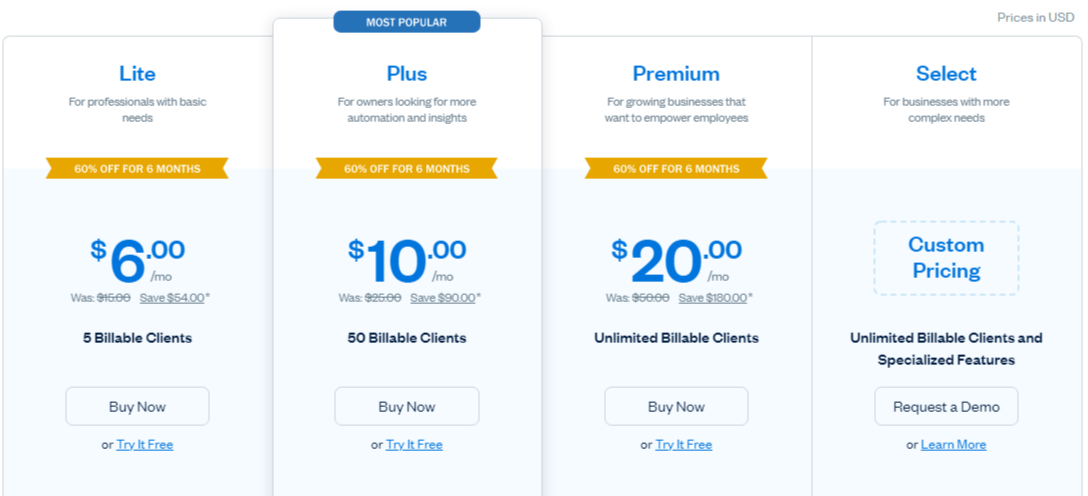The Freshbooks pricing section is effective for several reasons:
1. Clear Hierarchy and Visual Appeal:
- Distinct Tiers: The “Lite,” “Plus,” “Premium,” and “Select” tiers are clearly labeled and visually separated.
- “MOST POPULAR” Label: The “Plus” tier is highlighted as “MOST POPULAR,” guiding user choice.
- Consistent Layout: Each tier follows a consistent layout with descriptions, pricing, features, and call-to-action buttons.
- Visual Cues: The use of distinct font sizes and the “Custom Pricing” box enhance visual clarity.
- Clear Headings: The headings clearly indicate the purpose and target audience of each tier.
- Pricing Clarity: The monthly prices are prominently displayed.
- Call to Action Buttons: The “Buy Now,” “Try It Free,” “Request a Demo,” and “Learn More” buttons are visually distinct and clearly labeled.
- Discount Highlight: The “60% OFF FOR 6 MONTHS” banner is prominently displayed.
- Currency: The display of “Prices in USD” is present.
2. Value-Based Differentiation:
- Targeted Descriptions: Each tier has a concise description that clearly identifies the target customer and their needs.
- Feature Progression: The billable client limits clearly show the increasing capabilities of each tier.
- Specific Feature Differentiation: The “Select” tier offers “Unlimited Billable Clients and Specialized Features,” differentiating it from the others.
- Quantitative Differentiation: The differences in billable client limits provide clear quantitative differences.
- Discount Clarity: The “Was” and “Save” amounts are clearly shown, demonstrating the value of the discount.
3. Transparent Pricing:
- Clear Pricing Information: The discounted monthly prices are clearly stated for the “Lite,” “Plus,” and “Premium” tiers.
- Custom Pricing: The “Select” tier uses “Custom Pricing,” indicating a tailored solution for larger clients.
- Free Trial Offer: The “Try It Free” option for the “Lite,” “Plus,” and “Premium” tiers reduces the barrier to entry.
4. Addressing Different User Needs:
- Basic Needs: The “Lite” tier caters to professionals with basic needs.
- More Automation: The “Plus” tier is designed for owners looking for more automation and insights.
- Growing Businesses: The “Premium” tier caters to growing businesses that want to empower employees.
- Complex Needs: The “Select” tier caters to businesses with more complex needs.
5. Strategic Use of Information:
- Benefit-Oriented Descriptions: The descriptions highlight the key benefits of each tier.
- Clear Call to Action: The call-to-action buttons provide clear paths for action.
- “MOST POPULAR” Highlight: The “MOST POPULAR” label on the “Plus” tier influences user choice.
- Discount Incentive: The significant discount incentivizes users to subscribe.
- Feature Lists: The billable client limits clearly show the differences between the tiers.



